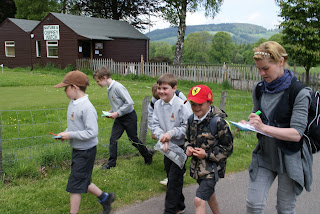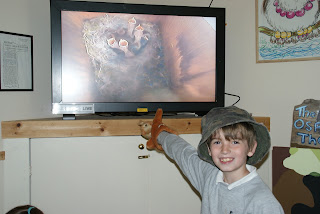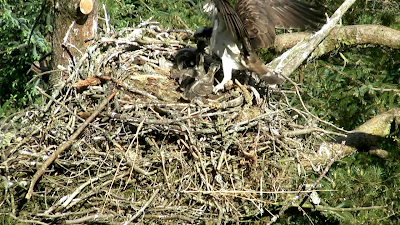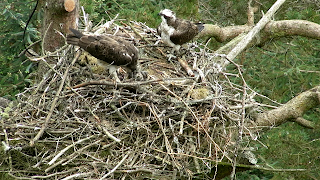The children from class P4/5 visited the Osprey and Nature Watch centre at Kaizlie Gardens to see the ospreys on camera. They got together back at school and wrote a collective piece about thier visit to share with the public on this blog.
Below is their account of the visit:
On June the 6th, P4/5 from St Ronan’s Primary School in Innerleithen went on an adventure to Kailzie Gardens to see what happens at the amazing Osprey Centre.
We saw live footage showing us ospreys, blue tits and herons but the most important thing for us were the ospreys because we are learning about them in our topic.
We saw three baby osprey chicks being fed by the mum. She was giving them raw fish that the dad had just caught fresh from the river. Their mum tore off tiny little scraps of fish, the right size for the osprey chicks, and the size would be dependant on the age of the chicks.
The chicks got fed one at a time, getting equal amounts. They didn’t push and shove, they waited patiently, they took turns to feed. They were very civilised. The chicks had a wee sleep after their meal and mum got to eat her share.
The chicks got fed one at a time, getting equal amounts. They didn’t push and shove, they waited patiently, they took turns to feed. They were very civilised. The chicks had a wee sleep after their meal and mum got to eat her share.
Dad came back to eat last after the chicks and mum. He took what was left and flew off the nest to finish all that was left, including the head and the brains. It is very nutritious! The ospreys are really good parents - we saw that the chicks were never left alone.
 We saw the chicks exercising by stretching their wings and moving around the nest. Another reason the chicks move around the nest is to move to the edge of the nest to poop. They poop over the edge to keep the nest clean.
We saw the chicks exercising by stretching their wings and moving around the nest. Another reason the chicks move around the nest is to move to the edge of the nest to poop. They poop over the edge to keep the nest clean. This also gives Tony Lightley, the man who rings the chicks, an estimate of how old the chicks are because of how far away from the nest the poop goes. The older the chicks, the further the poop! Whenever the birds pooped out of the nest, Di missed videoing it!
The parent birds can get quite bored protecting the chicks so they entertain themselves by moving sticks around the nest. We saw how the nest was as big as a double bed. The nest needs to be that big because the chicks grow so quickly and they are so big when they stretch their wings out, they need the space to not knock each other out of the nest. We saw mum redecorating the nest by moving moss and sticks around. She also moved the moss to keep the nest clean of fish bones and fish blood, to stop diseases.
We enjoyed watching the ospreys. We could highly recommend visiting the centre to watch the live footage, play games and learn new things about the ospreys.
Thank you for reading our blog entry!
P.4/5, St Ronan’s Primary School, Innerleithen





